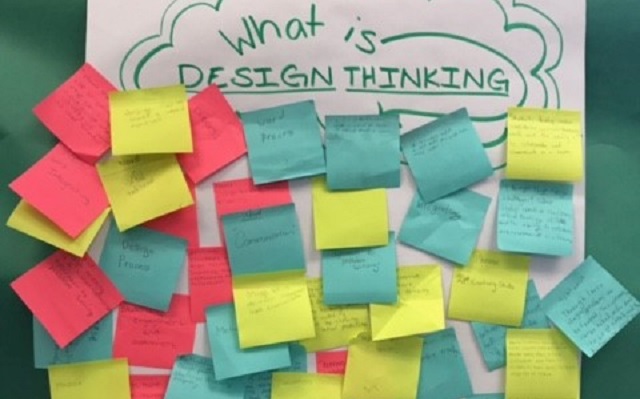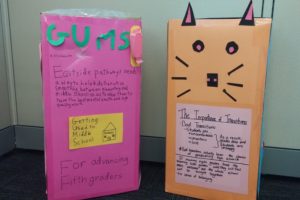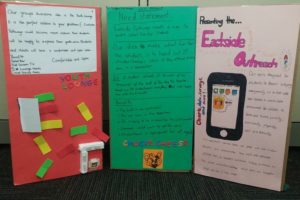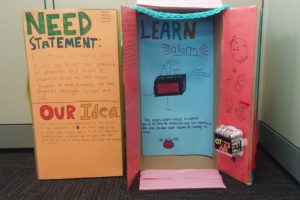Eastside Pathways was invited by Bellevue School District to present a challenge for the students taking part in Operation IDEATION. For Eastside Pathways, it was an excellent opportunity to integrate youth voice into their work.
Operation IDEATION was a three-week summer program sponsored by the Bellevue School District, for students entering grades 7 and 8 in the fall of 2017. The focus was on fostering innovative through the Design Thinking framework among youth. The program was conceived and developed by Debbie Brandt, Curriculum Designer and Program Administrator for the Bellevue School District.
According to Debbie: “Students in 7th and 8th grades are natural idea-generators, and the program was designed to give them a place and opportunity to use their skills to solve authentic problems. This experience will, in turn, enhance their creative confidence and self-esteem. Design Thinking is a problem-solving method that provides students with life-long skills, which can be applied to academics and is highly relevant in today’s world. It is organic and authentic, with ideas generated by the students.”
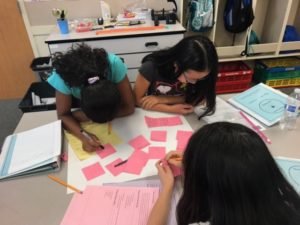 The program was in two phases. In the first two weeks, the students learned, practiced, and applied the five elements of Design Thinking framework.
The program was in two phases. In the first two weeks, the students learned, practiced, and applied the five elements of Design Thinking framework.
- Empathy: problem finding through observing and interviewing people
- Define: determining and defining the need and problem
- Ideation: generating many ideas/solutions for the defined need and choosing one
- Prototyping: creating a prototype of the idea/solution
- Testing: pitching the idea and getting feedback
- Repeat: recycling through the process, based on feedback to more accurately meet the need
In the third week, the students met their client, Eastside Pathways, and worked on a real-life challenge. They interviewed Stephanie Cherrington, Executive Director, and Cathy Habib, Lead Facilitator, to better understand what the organization does to serve the community and identify the specific needs of the organization.
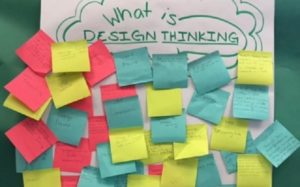 Following the hour-long interview, the students studied their notes and developed some insights from the information presented to them. A few of their insights:
Following the hour-long interview, the students studied their notes and developed some insights from the information presented to them. A few of their insights:
- Attendance, which might not seem like a big factor in early elementary school, can end up being a big factor, causing stress and problems for the students.
- Attendance problems are not based only on students; parents have to establish routines to get students to school and on time.
- Transitions (from elementary to middle school and middle school to high school) are not only about academics; they are also about social and emotional feelings of kids.
- Students transitioning (from elementary to middle school or middle school to high school) need support from the entire community for the transition to be smooth.
- Going to a new school can affect your experience on learning.
- Youth voice is important in improving the school experience.
- Every voice matters.
- For every problem, there is a solution, which results in another problem.
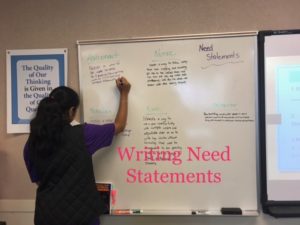 The students then determined the organization’s needs and worked with their teams through the Design Thinking process. They designed prototypes (idea boxes) with their ideas in three areas – Attendance, Transitions, and Youth Voice. These solutions were presented to Stephanie Cherrington and Cathy Habib. This part of the Design Thinking process was about testing their ideas and getting feedback, to make improvements to the initial ideas.
The students then determined the organization’s needs and worked with their teams through the Design Thinking process. They designed prototypes (idea boxes) with their ideas in three areas – Attendance, Transitions, and Youth Voice. These solutions were presented to Stephanie Cherrington and Cathy Habib. This part of the Design Thinking process was about testing their ideas and getting feedback, to make improvements to the initial ideas.
Following the presentation, a delighted Debbie shared her excitement at the students’ success for Eastside Pathways: “I am still grinning from ear to ear…what an experience! I want to say BIG thank you to Eastside Pathways for committing their time to be our ‘client’, as this made Operation IDEATION a big win for our students!”
Stephanie acknowledged the wonderful talent and ideas of the young students: “It was a terrific experience for Eastside Pathways. Student voice is essential if we are going to shape systems that work better for them.”
Eastside Pathways will share the idea boxes with members of their Attendance and Transitions Collaboratives. They are also planning to put together a display of the boxes and showcase them at some of their partner organizations.
Some of the idea boxes designed by the students
- Transition
- Outreach
- Attendance
Program Specifics
- The program ran 12 days, over three weeks, at Somerset Elementary School. Students were in class from 9 a.m. – 1 p.m., with a 20-minute snack and recess.
- There were two classes of 22 and 21 students.
- Demographics
- Gender: Male – 28; Female – 15
- Grade Level: Entering Grade 7 – 23; Entering Grade 8 – 20
- Ethnicity: American Indian/Alaska Native – 1; Asian – 28; Black – 1; Latino – 3; Multi-Ethnic – 4; White – 6
About Design Thinking
Design Thinking is a problem-based learning framework that guides and encourages creative and unconventional thinking for solving the problems of today and tomorrow. Design Thinking has a long history, beginning pre-1960. In 1987, Peter Rowe of Harvard Graduate School of Design published his book titled Design Thinking. Four years later, IDEO Corporation showcased the Design Thinking process as a way to navigate authentic problems. Finally, in 2005, Stanford University capitalized on the principles, by creating The d.School, and began teaching engineering students Design Thinking, as a formal method.
Source: Wikipedia
Article edited by Sujata Agrawal, communications manager at Eastside Pathways from a summary note written by Debbie Brandt, Curriculum Designer and Program Administrator for the Bellevue School District

